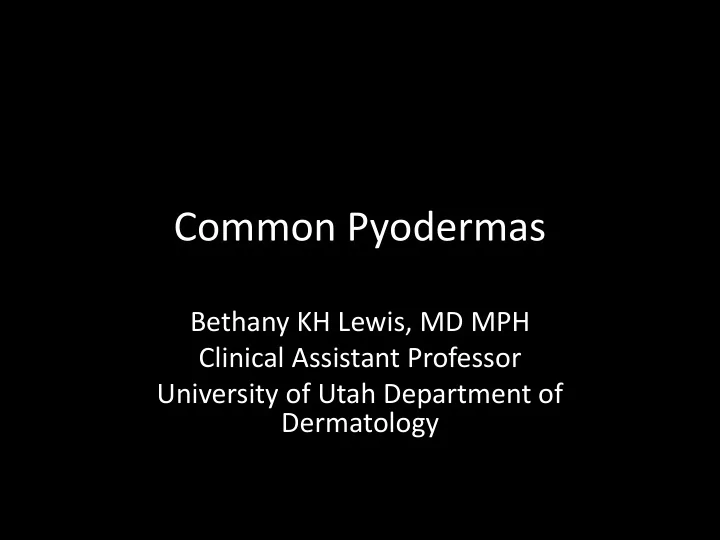

Common Pyodermas Bethany KH Lewis, MD MPH Clinical Assistant Professor University of Utah Department of Dermatology
I HAVE NO CONFLICTS OF INTEREST TO DECLARE
Today’s agenda • Skin microbiome review • Clinical presentations of pyodermas – Impetigo – Folliculitis – Cellulitis • Treatment guidelines
Pyoderma • “Pyo” – pus • “Derma” – skin • Pyoderma – skin infection forming pus, or bacterial skin infection • Primary causative agents: Staph aureus and Strep pyogenes
Skin microbiome 1,2 • One billion organisms per cm 2 of skin • Colonization starts at birth, diversifies w/ age • Bacterial species vary by site – Sebaceous/follicle – Propionibacterium, Staphylococcus – Body folds – Corynebacterium > Staphylococcus • Inflammatory diseases have been a/w altered microbiomes – Atopic dermatitis, rosacea, acne
Homeostasis disruption pyodermas 2 1. Balance between skin and microorganisms Environmental trauma – i.e. shaving, wounds, other • Underlying skin barrier issues – i.e. atopic dermatitis • Predisposing conditions – i.e. immunosuppression, diabetes • 2. Disturbance of microorganism milieu Staph aureus overgrowth – i.e. homogenization 2/2 exposure • Decrease in diversity –
Superficial pyodermas are common 4 • Impetigo 0.3% • Cellulitis 2.2%
Classification of pyodermas Folliculitis Impetigo Cellulitis
Bacterial Infections Epidermis Impetigo Dermis Cellulitis Appendages Folliculitis Slide modified from and courtesy of Scott Florell, MD
FOLLICULITIS
Not all folliculitis is bacterial folliculitis 5 Majocchi’s granuloma DDX includes : • “Hot tub” – Pseudomonas • Herpes simplex • T. rubrum , Candida , Pityrosporum • Drugs or occupational Eosinophilic folliculitis – Topical or PO steroids, lithium – Chloracne • Nutritional deficiency • Eosinophilic
Bacterial folliculitis 5,7 Diagnosis Treatment • Bacterial swab for Gram • Anti- Staph medications: stain and culture – Topical antibiotics • Clinda/erythromycin lotion • KOH to evaluate for yeast or or solution fungus • Mupirocin ointment • HSV PCR or DFA – Antimicrobial washes • Benzoyl peroxide 10% wash – If extensive involvement, 5-10 day course PO ABX
When the hair follicle is more extensively involved 7 Furuncle/Carbuncle/Abscess • Diagnosis: – Try to differentiate from inflamed epidermoid cyst • Treatment: – Incision & drainage – Culture & sensitivity – Empiric TMP/SMX or doxycycline – Defined MSSA: dicloxacillin or cephalexin – Defined MRSA: TMPSMX
Compare & Contrast Inflamed EIC Furuncle/Abscess
Decontamination procedures • Intranasal mupirocin BID x 5 days • Daily chlorhexidine washes vs. dilute bleach baths • Daily decontamination of personal items
Bacterial Infections Epidermis Impetigo Dermis Cellulitis Appendages Folliculitis Slide modified from and courtesy of Scott Florell, MD
IMPETIGO
Impetigo • Superficial epidermal infection, predominantly Staphylococcus
Impetigo • Thin-walled vesicles/pustules, easily rupture & crust with a “honey” color • Exposed areas: face, hands, neck, extremities
Impetigo 7 • Diagnosis: • Treatment: – Consider a wound – Topical antibacterial culture to differentiate • Mupirocin Staph vs. Strep – +/- systemic antibiotic if: – Typically this is MSSA • extensive involvement • outbreak situation • glomerulonephritis- causing S. pyogenes strain • 7 d. PO cephalexin or dicloxacillin
Bacterial Infections Epidermis Impetigo Dermis Cellulitis Appendages Folliculitis Slide modified from and courtesy of Scott Florell, MD
CELLULITIS
Cellulitis • Bacterial infection of dermis & subcutaneous tissue • Often occurs near areas of skin breakdown – Risk factors: • Venous stasis/edema • Toe web infections • Eczema • Legs > digits > other exposed sites
Cellulitis • Routine blood or wound cultures not routinely recommended • 5 days anti- Strep antibiotic for routine cases
Treatment guidelines for cellulitis 7 • Mild: without focus of purulence – PO peni/dicloxacillin, cephalosporin, clindamycin • Moderate: with systemic signs of infection – IV penicillin, ceftriaxone, cefazolin, clindamycin • Severe: failed orals, immunocomp, sepsis – Empiric vancomycin + piperacillin/tazobactam – Emergent C&S and possible debridement
References 1. Weyrich, LS et al. The skin microbiome: Associations between altered microbial communities and disease. Australasian Journal of Dermatology 2015; 56 : 268-74. 2. Schommer, NN & Gallo, RL. Structure and function of the human skin microbiome. Trends in Microbiology 2013; 21 (12). 3. Chen, YE & Tsao, H. The skin microbiome: current perspectives and future challenges. JAAD 2013; 69 : 143-55. 4. Stulberg, DL, Penrod, MA, & Blatny, RA. Common bacterial skin infections. Am Fam Physician Jul 2002; 66 (1): 119-125. 5. Luelmo-Aquilar, J & Santandreu, M. Folliculitis: recognition and management. Am J Clin Dermatol 2004; 5 (5): 301-310. 6. Baron, EJ et al. A guide to the utilization of the microbiology laboratory for diagnosis of infectious diseases: 2013 recommendations by the Infectious Diseases Society of America (IDSA) and the American Society for Microbiology (ASM). CID 2013; 57: 485-8. 7. Stevens, DL et al. Practice guidelines for the diagnosis and management of skin and soft tissue infections: 2014 update by the Infectious Diseases Society of America. CID 2014; 59 : 147-159. 8. Korownyk, C & Allan, GM. Evidence-based approach to abscess management. Can Fam Physician 2007; 53 : 1680-84. 9. Bernard, P. Management of common bacterial infections of the skin. Curr Opin Infect Dis 2008; 21 : 122-8. 10. Birnie, AJ et al. Interventions to reduce Staphylococcus aureus in the management of atopic eczema 2008. The Cochrane Collaboration , Issue 3.
Recommend
More recommend